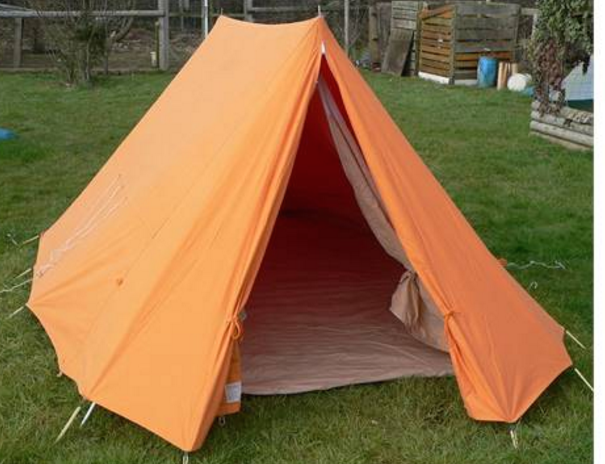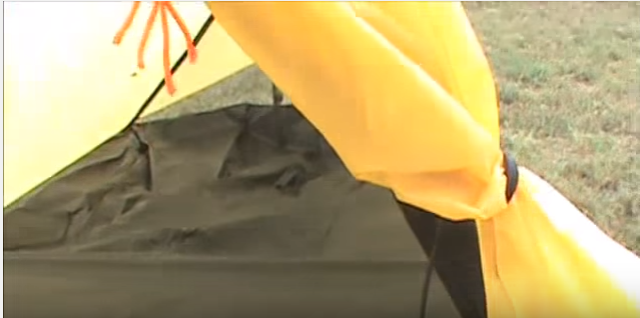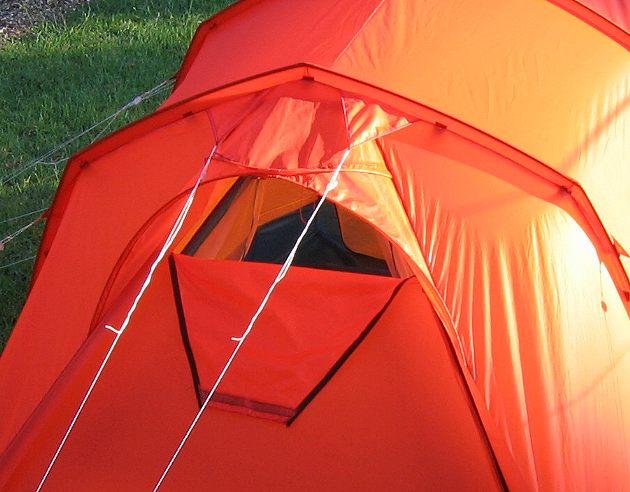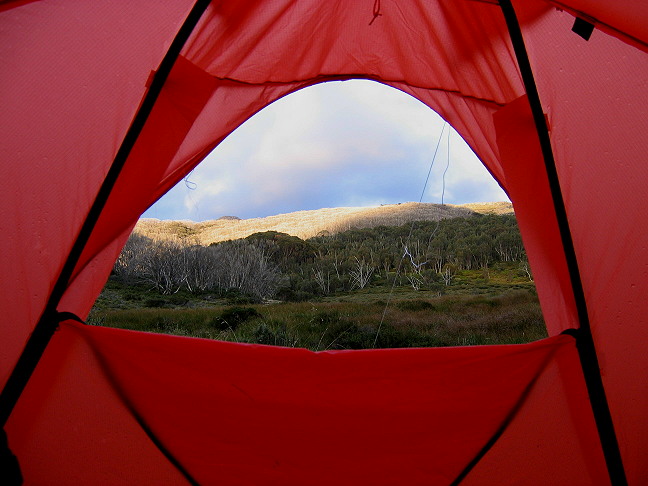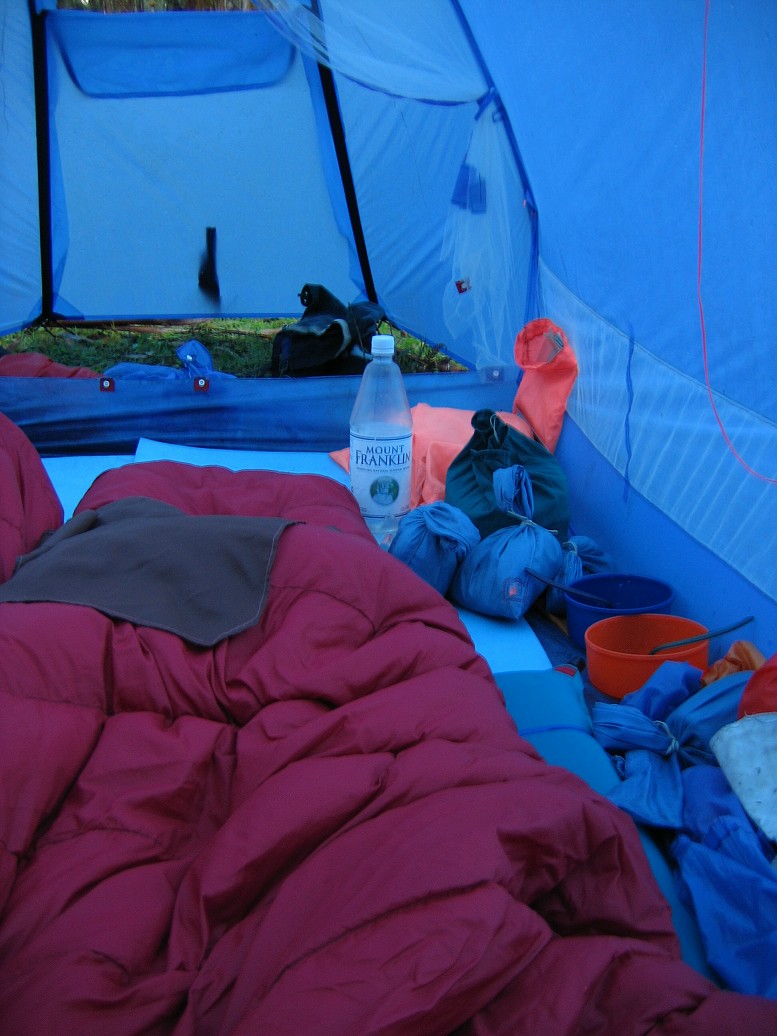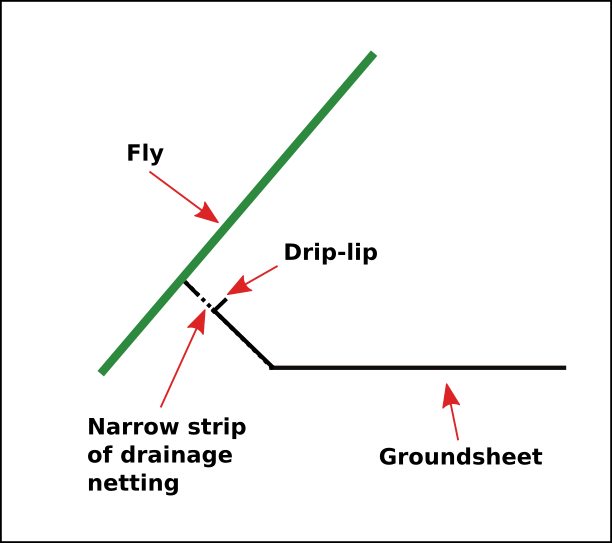Topic
Managing Condensation in a Single Skin A-frame
Forum Posting
A Membership is required to post in the forums. Login or become a member to post in the member forums!
Home › Forums › Gear Forums › Make Your Own Gear › Managing Condensation in a Single Skin A-frame
- This topic has 72 replies, 11 voices, and was last updated 8 years, 3 months ago by
 Geoff Caplan.
Geoff Caplan.
-
AuthorPosts
-
Oct 4, 2016 at 4:38 am #3429253
Hi folks
Another issue in my quest to design a solo tapered A-frame for lightweight use in exposed mountain and desert terrain. This will have sleeved trekking poles at the front, and sleeved DACs at the back to tension the side panels in bad weather.
I’m pretty much committed to going single skin – less weight, less faff, more space, and I’ve never been bothered by a bit of damp on the fly. But it does raise a couple of challenging design issues.
ISSUE #1: HOW TO MAXIMISE THROUGH DRAFT?
This is the easy one, I think, and also the most important issue for condensation management. Ideally, you have a sheltered and adjustable porch front and back, so you can keep the doors open in all but full-out storm conditions. And if you have to seal up you have sheltered vents in the fly, low in the back and high in the front to draw air through.
The simplest A-frame porch has a single panel on each side of a central zip, so you can have one panel open on either side, or both panels open in clement weather. Here’s the TrekkerTent Stealth – a really nice minimal A-frame that inspired to me start this project.

But for very little extra weight you can get something much more flexible. I think that Ultimate got it right with The Tent: You have 2 panels on each side of the porch, enabling you to fine-tune the shelter according to conditions and wind-direction, with the groundsheet well back from the drip line..
Even with both front panels open, the side panels give good shelter from side-winds and the porch is still helping provide tension for the ridge. And you still have the option of opening the porch fully on one or both sides.
Unless someone can point out a downside I’ve overlooked, I think I’ll be going with this 2 panel approach front and back. Coupled with double half-moon doors in the inner providing adjustable draught and bug protection, you have flexibility from fully open to fully battened down with every gradation in between.

I’m planning doors at both ends of the inner so I can adjust the rear porch from the inside – nothing worse than having get out of your pit and into the storm to seal up the back vent. It’s surprising how many big-brand designs get this wrong. And an adjustable rear door will help fine-tune through-draft.
ISSUE #2: HOW TO JOIN THE FLY TO THE FLOOR?
This is much tougher issue, I think.
Approach #1: drop a mesh wall off the fly
Much the most common approach with single-wall tarptents is to drop a wall of mesh from the fly to the floor. The TarpTent ProTrail would be the classic example:

This helps with airflow in still conditions and helps keep drips off the floor. But it also makes the tent very draughty in a cold wind, and lets in driven snow and dust. For my usage, this isn’t ideal, and I’m looking for alternative approaches.
Approach #2: have a mesh wall but make it sealable.
The Yama Cirriform has a cunning approach. In fair weather you pitch high with the fly well off the ground and the mesh on the walls is open. In low weather you drop the pitch so the fly is near the ground and the side-wall is shorter, allowing you to close off the mesh with a drawcord arrangement. But this requires a single, unsleeved pole, I think, so it’s easy to alter the pitch height. I can’t see how it could work with a sleeved A-frame. And it would be a royal pain if you were pitched high and got caught out by an unexpected storm at 3:00 am…
Alternatively you could have some kind of curtain to close off the mesh, held up by velcro, snap fasteners or a drawcord. This is relatively simple and should work OK, but would need some kind of arrangement to keep the curtain stored neatly when not in use. This has the advantage of flexibility, but at the cost of some faff and complexity.
Approach #3: catch the drips
The UK tentmaker Gram Counter has come up with the Drip-lip – a raised seam at the bottom of the wall. This catches drips before they can run onto the floor, and you’d simply mop up the damp before packing in the morning. I like this idea – elegant and zero faff, though you’d have to be careful to keep your down away from the sides..

Approach #4: sew the fly to the floor and damn the drips
This is the always-closed approach, the opposite to the always-open Pro Trail approach. Simply sew the floor to the bottom of the fly in a tube like the Stephenson Warmlite, and rely on through ventilation.
The downside, obviously, is increased condensation in still conditions. And condensation can run down the walls and onto the floor – through this could be managed by pairing it with the Drip-lip.
But there are compensating benefits:
- No faffing about with side curtains for battening down.
- No way for moisture rising from the ground under the fly to reach the inner tent, as there seems to be with the Pro Trail approach
- No need for separate tensioning for the fly and the bathtub – stretch out the fly and the floor is set up too.
So which way to go?
As with most lightweight design, this seems to be a question of tricky tradeoffs.
I’m tempted by the always-closed option with the Drip-lip because of it’s elegance and simplicity. By shutting out damp rising from the ground, the only condensation is from the occupant. And as a solo tent, there is only half the moisture you’d be getting in a double. Coupled with a good though-draft and the ability to open both ends fully in calm conditions, my gut feel is that condensation would be workable.
But I’d very much welcome any suggestions from your own experience.
Oct 4, 2016 at 6:39 am #3429261Hi Geoff
I really like my single skin tent, managing condensation is so much easier. Just last w/e I was out in a twin skin tent, morning temp was 4C under clear skies and lots of condensation on the fly. But separating the inner from the fly is a pain on this particular tent, so it just got packed up wet. With a single skin tent you just bring a j-cloth and wipe the consensation off from the inside. Ventilation helps a bit, but will not eliminate condensation in all conditions.
For joining the floor to the fly, I used a mesh wall bonded to the fly. I wrote up some details of it’s construction here https://backpackinglight.com/forums/topic/46644/
cheers, Stuart
Oct 5, 2016 at 11:15 am #3429486Geoff,
You are entering the realm of feature creep, which adds weight ;)
Here are some thoughts…
I have spent a lot of time under 8′ X 10′ tarps. They are long and wide enough that I don’t need a bivy and any rain splash or sideways rain doesn’t get my gear wet.
A net door will block some rain/snow from getting inside a shelter.
So, I would use mesh doors only, to keep most of the bugs out. If it is windy or cold the bugs won’t be a problem anyway.
Oct 5, 2016 at 12:48 pm #3429506Stuart – as a fellow Scot you probably understand my interest in robust, bug-proof shelters! Like you, I’ve never been too fazed by condensation – a J-Cloth or travel-towel will deal with most issues. As you say, once the outer gets wet in a double-skin tent you’re left with the option of splitting it, which is a pain, or getting the inner wet when you pack them together. And while you can easily wipe down an outer, drying an inner is more of problem.
Nick – you’re right – it will cost me around 120 grams to add zipped draft doors to the midge-net doors. But as I become ever more decrepit I sleep colder and colder, and in high alpine camps with my TrailStar I’m really feeling the cold night winds. I reckon that the draft doors will enable me to use a somewhat lighter quilt, so it’s not all loss. Also, I am planning trips to areas where driven dust and spindrift are common, and being able to batten down would be very useful. On balance, I think it’s worth the modest added weight. I think that Stuart will back me up when I say that very few people use a flat tarp above the treeline in Scotland or Scandinavia – it’s not much fun in our conditions.
Oct 5, 2016 at 1:53 pm #3429512I can honestly say that I have yet to see a tarp anywhere in Scotland. If there is no wind then in “summer” the midgies will get you and if there is wind, well it can be really windy.
Geoff – I am interested in how you get on, as you say trekking poles have potential to add rigidity to the tent structure.
Oct 5, 2016 at 4:28 pm #3429534Condensation management: a sponge.
Midge management … flame thrower. Sigh.
Cheers
Oct 6, 2016 at 5:53 am #3429613Roger – never use a flamethrower – it only makes them mad.
Oct 6, 2016 at 2:05 pm #3429677It balances – they drove me mad.
:-)Cheers
Oct 8, 2016 at 11:56 pm #3430140Since you are OK with swabbing condensation, I see why you are OK with single wall, and the trade-off is between ventilation and protection from the weather.
Unfortunately, and perhaps due to local climate, condensation has frequently put a big damper on tenting, for me anyway. The foot of the sleeping bag gets soaked in the night, and the head and shoulders bump against the wet wall.
The sagging of the outer wall cramps available space even more. This is especially so with more moving about in the tent, as with cooking and eating. Have simply not found it possible to live comfortably in a tent during extended rain without an inner.A fine (‘no-see-um’) net liner has eliminated all of the wetness issues for some time, so am wedded to it. Agree that there must be a channel for the inner condensation to drain onto the ground, and not the tent floor, and the tent design and shape must promote draining, with outer canopy surfaces sloped as much as possible toward the ground.
Some have tried raising the inner netting to a higher point on the inside of the tent wall. But the head and shoulders are still going to get wet. Especially with a tent supported by an A-Frame of two trekking poles joined at the top. There is just not enough inside area resulting from that design to allow movement without rubbing against the inside of the single wall.
The are only two possible solutions that I’ve found: 1) A separate net inner, suspended from the outer so the inner is not exposed to rain during the pitch; with the floor joined to the inner, so the net inner can be swapped out with a solid one for colder weather, or replaced when worn out, since even the best net or gossamer fabric will degrade after a while. 2) Or, a WPB single wall. Black Diamond has shown that it can be done.
The problem is where to source very light WPB material with very high vapor permeability, so it functions even where there is less vapor pressure, as with a tent as opposed to a garment. But I keep looking, and may try something like the RBTR WPB. Note that to save weight, only the tent walls over the occupied area need be WPB, not the vestibules or awnings.
Apropos the wet packing issue, I think the availability of very light WP coated polyester materials will change that. Polyester does not attract water as nylon does, so I expect that it will be more packable after rain. Closer to cuben on this score, without the other qualities of cuben that some will not tolerate.
In the NE USA, many simply do not backpack at the height of bug season. Recall the days when hikers on adjoining peaks could only be seen from the legs up, because their upper bodies where surrounded by swarms of several varieties of bugs. The AT thru-hikers may have no way around this, not to mention extended rains, no matter how carefully they plan. But even in Colorado, perhaps due to climate change, periods of rain can be quite extended. Maybe I’m fussy, but getting self and gear completely soaked does not have to happen, and forget about being eaten alive by bugs. For those who differ, please recall Dan Durston’s observation after his PCT hike about the number of trekkers who disappeared into nearby towns whenever the going got nasty. For me the challenge is seeing how comfortably I can trek in the backcountry, not how miserable I can get.
Oct 9, 2016 at 1:00 am #3430145Have simply not found it possible to live comfortably in a tent during extended rain without an inner.
That is really a function of the tent design. An A-frame can drag fabric over your face; a single-skin dome or a single-skin tunnel does not.Which is better: to change the tent design or the tent fabric? I have yet to find the perfect tent fabric, so the latter option does not work for me. Even inside our 2-man tunnel we can get condensation under the right conditions. But we have the head room and a sponge. That works.
Cheers
Edited to clarify – RNC
Oct 9, 2016 at 1:13 am #3430147Roger,
I only backpack three seasons, and have never had to deal with moisture inside the tent using a net inner. Bless you both for your winter excursions.“Which is better: to change the tent design or the tent fabric?” Both, because both can be and are being improved, although nothing is perfect.
“An A-frame does that.” Not clear about your meaning. But can’t think of anything that an A-Frame does that I like. Guess they were OK for basic training in the military, because we were miserable anyway.
Oct 9, 2016 at 1:22 am #3430148Hi Sam
You are right: I was not clear. I have edited my posting to explain that i meant that the roof of an A Frame can drape itself around your head. Yeah – I have lived in one – as a Boy Scout.Cheers
Oct 9, 2016 at 8:30 am #3430158Floorless pyramid with bivy
The mid is taller so the surface is further from your face so more chance for the humidity to vent away
The walls are steeper so condensation more likely to run down to the ground
If it’s not real rainy leave the door open for ventilation. A “vent” has so little cross sectional area that it provides negligible ventilation. If it’s windy and you have to leave the door closed, it will tend to carry away any humidity.
(I know, you don’t want to hear from mid fanatics, just ignore this, I iterated on a number of A frame and tunnel designs and moved to mid : )
Oct 9, 2016 at 8:54 am #3430160Sam—Finally, a real-world assessment of single-wall drawbacks. I like the way your mind thinks and how you perfectly describe the problems. Your quotes—
“Since you are ok with swabbing condensation, I see why you are ok with single wall . . .” ZING.
” . . . condensation has . . . put a big damper on tenting, for me anyway. The foot of the sleeping bag gets soaked in the night, and the head and shoulders bump against the wet wall.”
“Have . . . not found it possible to live comfortably in a tent during extended rain without an inner.”
Amen, brother, pass the gorp and granola.
Agree with all your points. Plus, a net inner IS NOT a double wall tent. A full non-net inner canopy is a double wall tent.
And your bring up one of my rules for a backpacking tent: No part of your sleeping bag or body should touch the tent walls, whether single or double wall.
Another of my rules: A double wall tent will keep 90% of all tent condensation off you and your gear. I spend several nights in my red Akto with the inner tent unclipped and removed and the inner fly condensation was outlandish.
I may of posted this pic before but it shows me inside my Hilleberg Keron tunnel tent during a 75 hour December rainstorm on North Fork Creek in the Citico Wilderness.

This pic shows fly condensation dripping down onto my inner tent canopy during a cold night of rain. All this water scooted down the canopy and off on the ground. In a single wall all of this water would’ve landed on me and my bag and gear. But remember, this is in the Southeast mountains of NC during a winter rainstorm.
Oct 9, 2016 at 9:09 am #3430162Jerry says—
Floorless pyramid with bivy
The mid is taller so the surface is further from your face so more chance for the humidity to vent away
The walls are steeper so condensation more likely to run down to the ground
If it’s not real rainy leave the door open for ventilation. A “vent” has so little cross sectional area that it provides negligible ventilation. If it’s windy and you have to leave the door closed, it will tend to carry away any humidity.
(I know, you don’t want to hear from mid fanatics, just ignore this, I iterated on a number of A frame and tunnel designs and moved to mid : )
I lived in a Chouinard Pyramid tent back in 1986-87 and have some experience with a single wall “mid”. Just like this—
Regarding your quote—If you need a bivy to keep your bag dry while inside your shelter then in my opinion your shelter is substandard because it’s not providing the whole point of a shelter—to keep you dry and free from spindrift. I never carry a bivy because my tent performs this job by itself.
You say the Mid is taller which is true but in fact with my Pyramid the angled walls touched the footbox of my sleeping bag resulting in single-wall condensation wetness to the bag shell. Not good. A small Mid is therefore often too short for someone laid out fully. Why? Because the single pole in a mid uses up all the best space in a tipi tent. (You CAN tilt the pole over but then you’ve lost some stability).
Most cold rains fall in no wind so keeping my Pyramid door open was a non-starter. And if you look at most Mid doors they zip open very high which means rain will enter the tent almost into the center of the floor. Not good.
The biggest drawback with my Pyramid was threefold—Ground water sheeting and pooling in a typical Southeast deluge rainstorm, high open bald windstorms billowing out the structure and causing it to want to get airborne like an umbrella, and blizzard spindrift. Remember the Chouinard was designed as a winter tent with snow placed around the fabric perimeter to prevent wind and spindrift.
But many snowstorms start on bare ground and you have no snow to use as a barrier, so all this wind and blown snow comes in under the tent wall. Oh and of course there’s no sewn-in tent floor.
</div>
Oct 9, 2016 at 9:21 am #3430165Couple ideas to throw out there:
Maybe the inner layer is just to keep you from touching the outer layer that has condensation on it
Depending on the individual, maybe netting would be okay. You touch it and then know not to move further out. If you’re a “bull in a china shop” then you need a layer that physically prevents you from touching the outer layer.
The lightest weight breathable fabrics weigh as little as netting, so maybe they’d be better. Maybe the breathability is sufficient so the increased breathability of netting isn’t important.
The worst condensation is when it’s clear. The outer layer of the tent cools from radiative heat loss. This results in the most condensation. The inner layer is not subjected to the radiative cooling, so it’s not so cold, so there isn’t so much condensation. Plus there’s an air layer next to the outer tent layer that provides some insulation so the inner layer is warmer so there’s less condensation.
I’ve had fabric just suspended with no human inside producing water vapor. Radiative heat loss cools the fabric and there’s a lot of condensation on both sides of the fabric.
Oct 9, 2016 at 3:35 pm #3430232Have to agree with Tipi on both postings.
However, I cannot agree with Jerry here:
Maybe the inner layer is just to keep you from touching the outer layer that has condensation on it
Depending on the individual, maybe netting would be okay. You touch it and then know not to move further out. If you’re a “bull in a china shop” then you need a layer that physically prevents you from touching the outer layer.
The inner tent has far more important purposes: to block wind and spindrift, and to provide a thermal step between you and the fly (ie, keep warm air trapped). Netting cannot do any of those things, not at all. A netting inner may keep out insects (which is certainly worth while), but it does not make a double-skin tent. Not in a million years.As for the idea that the inner tent is to stop you from moving too far – I have to ask how it does that at 3 am when you are fast asleep. Ha! We manage to stop ourselves from rolling sideways by piling lots of gear along the side between the mat and the side of the bucket groundsheet: large lumpy gear! That does work, just fine. It also keeps our quilts from touching the cold sidewall of the groundsheet and forming condensation there.
I think some of the worst condensation we have ever had was after a rainstorm at the end of a hot day when the clouds cleared away during the night. The clear sky was certainly cold (effectively about -70 C), but the warm ground was boiling the recent rain water off the ground at a huge rate! The total lack of any wind just added to the problem. Much sponging in the morning.
Cheers
Oct 9, 2016 at 3:54 pm #3430233I always like to argue with Roger? Maybe he’s just sore I called him Alzhiemered? (No, he did that) : )
I just threw out some ideas. I also pointed out due to radiative and conductive heat loss the inner layer is warmer, so thus less condensation. Yeah, netting not so good in this respect although you could get some air layer skin effect.
When I’m sleeping I never touch the inner tent layer that has condensation, because I’m down on the ground sleeping. The time I touch it is when I get up in the morning, sit up, then my head or shoulder will typically touch it and get wet. If there was any inner layer, it would tell me I’m getting close so should stop. I don’t worry about this though, I just have single layer, I have a high enough peak so there’s enough room I can mostly avoid this.
The worst condensation I’ve experienced was clear and no wind, like your case. What I do in that case is leave the door open so there’s a lot of ventilation. At least as much ventilation as possible. That helps. And I have steep walls so the condensation tends to run to the ground rather than drip on me. And don’t have tent floor near the edge of the tent to catch the drips so it puddles up and then runs towards me..
Oct 9, 2016 at 4:32 pm #3430245Hi Jerry
The time I touch it is when I get up in the morning, sit up, then my head or shoulder will typically touch it and get wet.
You should try it when it’s -10 C outside and what is on the inside of the inenr tent is a thick layer of frost. Get that down the back of your neck when you sit up and … :-)steep walls so the condensation tends to run to the ground rather than drip on me.
Very much so. The walls on my tunnels are vertical at ground levelCheers
Oct 9, 2016 at 4:49 pm #3430252This seems to be an issue with polarised views! So how to make sense of it?
First, I suspect that a lot of this boils down to usage and priorities. Some people are so concerned with weight that they thru-hike under a Gatewood Cape. Too hard-core for me. Others won’t leave home without the comfort of a double-walled Akto or Scarp, but I’d find that too heavy. Headroom, space, protection from damp walls – we all have different priorities. I guess that’s why there are so many designs – .one person’s ideal shelter would be another person’s hellhole…
Personally I’m rarely awake in my tent, so I’ll put up with a little inconvenience to save weight, but not with major discomfort. If I want a genuinely storm-worthy shelter at under 800g something’s going to have to give, and for me I’m pretty confident I can sacrifice the weight and complexity of an inner. I’ve got around 100 nights under my belt with the single skin TrailStar, and condensation have never been more than a minor inconvenience. Clearly, keeping my down dry is the bottom line and so far nothing has penetrated the DWR of my bag. And despite the dire warnings, most people do seem to manage fine in single skin A-frame designs – even in the PNW. The ProTrail is a best seller, and the Yama and HMG designs have many devotees. I’ve read every review I can find, and very few seem unhappy with their choice.
But my issue, as I said in the OP, is that they all vent from low on the side. This is a cold design which also lets in spindrift and dust. Fine in some climates – but an issue in others (especially for a cold sleeper). So I’m trying to move the venting to the ends where it’s more controllable.
From my experience with both tents and tarps I’ve found that the key to condensation control is through-draft For an A-frame this means paying careful attention to sheltered vestibules at both ends that can be kept open in almost all weathers, and a flexible door system to control bugs and keep the draft above my face and quilt if it’s cold. This stems from my experience with Quasar-style “dunnel” designs – a draft through the living area keeps the outer quite dry in most conditions, and we do have the odd drop of rain over here in the UK :-)
I haven’t seen many single-skin designs that offer this kind of sheltered end-to-end through-draft, so I’m hoping for hands-on feedback from anyone who has used it in the field. The Akto was mentioned as a warning, but from what I’ve seen it’s ventilation is much more limited. My own Laser-style cross-pole doesn’t vent well at all. With the single side-door in this design, through-venting is highly compromised. A big 3-4 person tent like the Keron is a whole different ballgame – no experience so I can’t comment.
Oct 9, 2016 at 5:33 pm #3430267Hi Geoff
Just so. A subtle detail can have enormous influence here. First, have a look at this tent, which I made for someone else in 2005:
Both ends have zip-up doors with 2 zips, which leave windows at the top under a small hood. This design gives excellent through ventilation and rain does not land on the groundsheet. Now contrast this with the next tent (made in 2002), which has far less through-ventilation:

What is the key difference? It’s the shape of the vestibule. The first tent has a vestibule with a square end ( with two zips and two stakes); the second has a vestibule with a point (one zip & one stake). You cannot get an adjustable top window with a pointed vestibule, but you can get an excellent end window and ventilation with a square vestibule. About the only objection to the square-end version is that you need an extra stake.
Cheers
Oct 10, 2016 at 2:03 am #3430334Roger – you make a key point, I think.
As you can see from my visualisations, I’ve already decided on a square-ended vestibule, so we’re thinking the same.
The open issue is how to do the zips. With the square door of the tunnel, the two-zip approach makes the most sense. With the triangular door of the A-frame I think I can get away with a single central zip – lighter and one less thing that can break.
Ultimate’s The Tent and Vango’s Force 10 use the single zip up the middle of the center panel, with toggles to hold the door open.
 .
.This gives you a good-sized opening with the side panels on the pegs. Of course in calm weather you can also take one or both of the side panels off the pegs and toggle the whole porch to the pole, leaving the end completely open.

With a self-locking zip and an extra toggle or two, the size of the opening would be very adjustable. And with the force mainly going down the seams, I don’t think the zip would be under much pressure.
But I think that both these designs could be improved by stopping the zip a little short of the top of the panel, leaving more of a hood to protect the sleeping area from the drip line. The hood could (should?) also contain a vent.
This would involve ducking a little lower to enter, but it would still be much better than my TrailStar, which is a pig to get into on a low pitch.
Drip-line protection will be further improved by canting the poles, so the pole junction at the top will be a few inches forward of the front of the bathtub.
I’m planning something similar for rear. This will be quite fiddly at the smaller end, but I want the flexibility. Most tapered designs simply have a vent there, but I don’t think that offers enough air-flow. Or they leave it unprotected with a storm flap, which is neither aerodynamic or flexible in bad weather. Plus the flap can usually only be closed from the outside – something I’m keen to avoid. With a full door arrangement at the rear I can do all the adjustments from inside without leaving my pit and stepping out into a monsoon. Probably too much work to be viable in a commercial design, but that’s the benefit of MYOG :-)

None of the better known lightweight A-frames seem to have paid much attention to the front porch – I guess because weather protection is seen as less important in US conditions. The 3-panel design used in the traditional UK designs gives a lot more flexibility for ventilation and for sheltering your stove.
As I’ve said, my hope is that better porch design will compensate for the reduced side ventilation compared to the US approach of dropping mesh walls to connect the bathtub to the fly.
PS – I’ve just discovered that the Bear Paw AT A-frame comes by default with a floor sewn directly to the side. He a dropped mesh wall as an option, but says that the ventilation is fine without it.
 Oct 10, 2016 at 2:54 am #3430336
Oct 10, 2016 at 2:54 am #3430336Hi Geoff
Sorry, but I am not sure you understood my point about having two zips.
Having 2 zips lets you have a really good ventilation window at the peak of the end of the tent. The pic above shows the little verandah which goes over the window to keep the rain out.

This pic shows the effect from the inside. The opening of the window is adjustable from almost nothing to wide open. On the windward end the window can be shut and sealed with Velcro across the top to keep spindrift out.
With the end poles canted outwards, the window is far away from the groundsheet too. This works with a single-skin tent just as well:

You can see the vestibule space here behind the two-zip end.
Cheers
Oct 10, 2016 at 3:09 am #3430337Ah – I see what you were driving at!
Oct 10, 2016 at 4:34 pm #3430461Well, you guys have got me thinking about a better way to connect the bathtub to the wall.
The idea is to keep out the draughts while still allowing drips to drain. The diagram shows a thin strip of bugnet sewn or bonded to the fly – just wide enough to allow drainage but narrow enough to keep out pretty much all draughts, spindrift etc. The net strip is attached to the groundsheet with a raised seam that would act as a Drip-lip. Condensation would run down the wall and be caught by the drip lip till it drained through the net.
Plus hanging the floor will make it easier to tension the fly by creating a degree of freedom between the fly and the floor.

This looks like it would meet my design goals, unless anyone can spot a flaw that I’m missing.
-
AuthorPosts
- You must be logged in to reply to this topic.
Forum Posting
A Membership is required to post in the forums. Login or become a member to post in the member forums!
Our Community Posts are Moderated
Backpacking Light community posts are moderated and here to foster helpful and positive discussions about lightweight backpacking. Please be mindful of our values and boundaries and review our Community Guidelines prior to posting.
Get the Newsletter
Gear Research & Discovery Tools
- Browse our curated Gear Shop
- See the latest Gear Deals and Sales
- Our Recommendations
- Search for Gear on Sale with the Gear Finder
- Used Gear Swap
- Member Gear Reviews and BPL Gear Review Articles
- Browse by Gear Type or Brand.

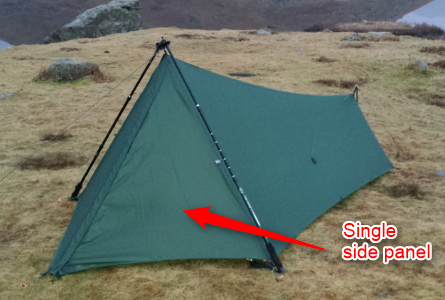
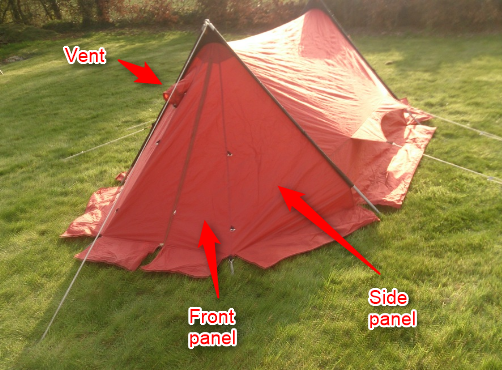

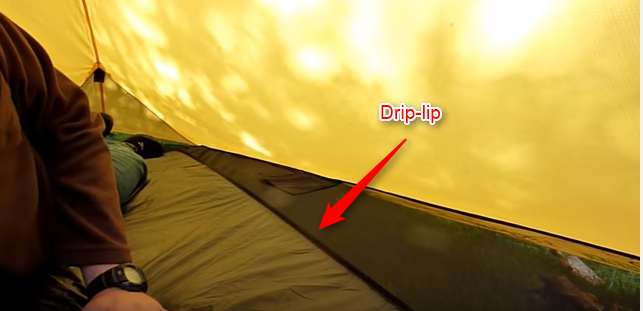

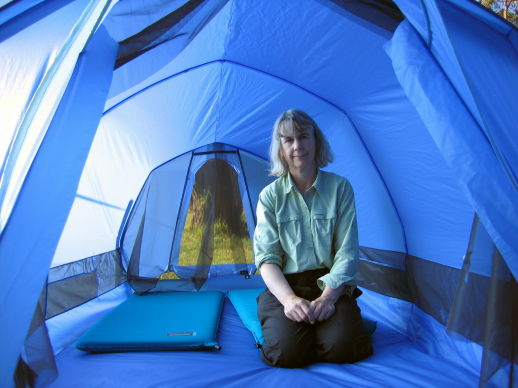
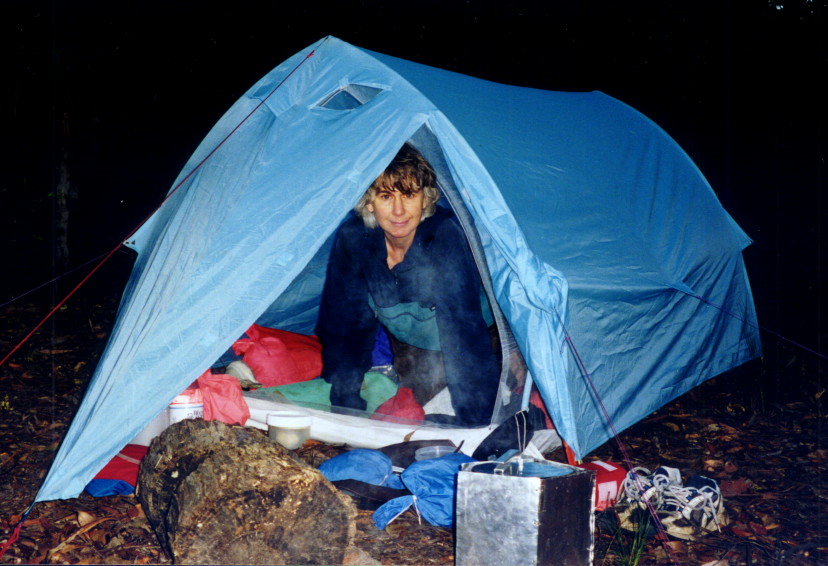
 .
.